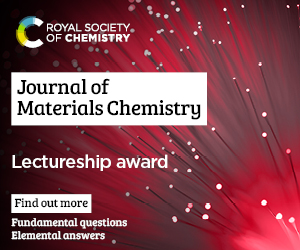Jessica Winter, Editor-in-chief
Ohio State University, USA
Jessica Winter is a Professor in the William G. Lowrie Department of Chemical and Biomolecular Engineering and the Department of Biomedical Engineering, Associate Director of the MRSEC Center for Emergent Materials at the Ohio State University, and Past Chair of the Nanoscale Science and Engineering Forum of the American Institute of Chemical Engineers.
She received her PhD in Chemical Engineering from the University of Texas at Austin in 2004, and completed a postdoctoral fellowship at the Center for Innovative Visual Rehabilitation at the Boston VA Hospital in 2006. Her research interests include nanomaterials for cancer imaging, diagnostics, drug delivery; and cell migration in the brain tumor microenvironment.
Jessica is a co-founder and Chief Scientific Officer of Core Quantum Technologies, a company commercializing nanoparticle reagents for leukemia diagnostics. She has received the American Chemical Society Rising Star Award and the Golden Mouse Trap Engineering Rising Star Award; she was named to Top 25 STEM professors in Ohio; and is a fellow of the AAAS, AIMBE, and senior member of the IEEE and AIChE.
Kaushik Chatterjee, Associate Editor
Indian Institute of Science, India
ORCID:
Prof. Kaushik Chatterjee obtained a Ph.D. in Bioengineering from the Pennsylvania State University. He pursued his postdoctoral fellowship jointly at the National Institute of Standards and Technology (NIST) and the National Institutes of Health (NIH) supported by a Research Associateship from the US National Research Council. He joined the Indian Institute of Science (IISc) in Bangalore in 2011 as an Assistant Professor. He is currently a Professor in the Department of Materials Engineering and the Centre for BioSystems Science and Engineering.
His research interests lie in developing and processing materials for biomedical applications. Specifically, his group focuses on scaffolds for tissue engineering, engineering organotypic tissue models, metallic biomaterials for medical implants, additive manufacturing, 3D printing, and bioprinting.
Elizabeth Cosgriff-Hernandez, Associate Editor
The University of Texas at Austin, USA
Dr. Elizabeth Cosgriff-Hernandez is a Professor of Biomedical Engineering at The University of Texas at Austin and holds the L.B. (Preach) Meaders Professorship in Engineering. She received a B.S. in Biomedical Engineering and Ph.D. in Macromolecular Science and Engineering from Case Western Reserve University under the guidance of Professors Anne Hiltner and Jim Anderson.
She then completed a UT-TORCH Postdoctoral Fellowship with Professor Tony Mikos at Rice University with a focus in orthopaedic tissue engineering. Dr. Cosgriff-Hernandez joined the faculty of at Texas A&M University as an Assistant Professor in 2007 and the University of Texas at Austin in 2017. Her laboratory specializes in the synthesis of hybrid biomaterials with targeted integrin interactions and scaffold fabrication strategies.
Gemma-Louise Davies, Associate Editor
University of Birmingham, UK
ORCID ID:
Dr Gemma-Louise graduated from Trinity College Dublin (Ireland) with a Degree in Natural Sciences (Mod. Chemistry) and remained there to undertake a PhD in Inorganic and Materials Chemistry (awarded in 2011).
Following a brief industry-supported Postdoctoral Fellowship in Trinity College Dublin, Gemma-Louise moved to the University of Oxford as a Postdoctoral Research Associate before being awarded a Global Research Fellowship at the University of Warwick in 2013. She joined the Department of Chemistry at University College London as Lecturer in Materials Chemistry and Director of the MSc in Materials for Energy and the Environment in July 2017.
Dr. Håkan Engqvist, Associate Editor
The Ångström Laboratory, Uppsala University, Sweden
ORCID:
Dr. Håkan Engqvist is a professor of Applied Materials Science at Uppsala University, Sweden. He holds a Master's degree in Material Physics and a PhD in Materials Science from Uppsala University. With eight years of industry experience in ceramic materials, specializing in tooling applications and bioceramics, Dr. Engqvist joined Uppsala University as a professor in 2009.
His research focuses on the synthesis, structure, and properties of biomaterials, particularly bioceramics used in hard tissue replacement and drug delivery. Dr. Engqvist also serves as the Director of the MedTech Science and Innovation Centre at Uppsala University, contributing to the advancement of medical technology and fostering innovation. His expertise combines an academic background with industry experience. The research work aims to the understanding and development of biomaterials for critical applications in healthcare.
Shaoqin Liu, Associate Editor
Harbin Institute of Technology, China
Professor Shaoqin Liu received her Bachelor degree and Ph. D degree from Wuhan University of Hydraulic and Electric Engineering in 1994 and from Changchun Institute of Applied Chemistry (Chinese Academy of Science) in 1999, respectively. She started her chemistry research career under Professor Shaojun Dong group at Changchun Institute of Applied Chemistry to develop polyoxometalates-based thin film.
After her Ph. D degree, she moved to Max-Planck-Institute of Colloids and Interface as Humboldt Fellow. She developed polyoxometalates-based functional materials. In 2004, she joined National Research Council of Canada as NESRC fellow to study direct methanol fuel cells. In 2007, she started her academic career as a Full Professor in Harbin Institute of Technology. Her current research interests include preparation of nanostructured materials and their applications in energy, biosensing and cancer therapy.
Yoshiko Miura, Associate Editor
Kyushu University, Japan
ORCID:
Yoshiko Miura is currently Professor in Chemical Engineering and Polymer Chemistry at Kyushu University, Japan. She studied polymer chemistry and biopolymer chemistry at Kyoto University under Prof. Yukio Imanishi and Prof. Shiro Kobayashi, and received PhD in 2000. From 2000 to 2001, She spent her postdoctoral period at the University of Pennsylvania in Professor Virgil Percec’s group. In 2001, she then returned to Japan and was appointed as Assistant Professor in Department of Biotechnology at Nagoya University. Then in 2005, she was appointed as associate professor at the School of Materials Science in Japan Advanced Institute of Technology. From 2010 to the present, she is a professor at Kyushu University. Her current research interests include the development of bio-based polymers of glycopolymers, biofunctional nanogels, porous polymers, and biomimetic materials.
Jun Wu, Associate Editor
The Hong Kong University of Science and Technology (Guangzhou), China
ORCID:
Dr Jun Wu earned his BS, MS, and PhD degrees from Nanjing University, SUNY Stony Brook, and Cornell University, respectively. From 2010 to 2015, he collaborated with Professors Robert Langer and Omid Farokhzad as a Postdoctoral Researcher at Harvard Medical School (HMS) and MIT. In 2015, he was promoted to Instructor at HMS. Following this, Dr Wu held the position of Professor of Biomedical Engineering at Sun Yat-sen University from 2015 to 2022. Since 2022, he has been an Associate Professor in the Bioscience and Biomedical Engineering Thrust at the Hong Kong University of Science and Technology (Guangzhou), while also serving as an affiliated Associate Professor in the Division of Life Science at the Hong Kong University of Science and Technology.
Dr Wu's research focuses on the development of functional and self-therapeutic biomaterials, including polymers and small molecules, designed to serve as drug carriers and tissue engineering scaffolds. His work aims to address critical health challenges, including cancer, diabetes, cardiovascular diseases, bone regeneration, and skin repair.
Myung-Han Yoon, Associate Editor
Gwangju Institute of Science and Technology (GIST), South Korea
ORCID:
Myung-Han Yoon is a professor at the School of Materials Science and Engineering at Gwangju Institute of Science and Technology (GIST), South Korea. He received his Bachelor’s degree in Chemistry (1999) and Master’s degree in Physical Chemistry (2001) at Seoul National University, South Korea. Then, he moved to the United States and received his PhD in Materials Chemistry at Northwestern University (2006). After finishing his postdoctoral research at the Department of Chemistry and Chemical Biology at Harvard University, he joined the School of Materials Science and Engineering, GIST, South Korea as an assistant professor (2010) and was promoted to associate professor (2015) and professor (2018). He received the Young Investigator Award from the American Chemical Society (2007), the Excellent Research Award from the Korean Polymer Society (2018), the Excellent Research Award from the Korean Chemical Society (2018), and the Excellent Research Award from the Minister of Science and ICT in South Korea (2019). His research interests include biomedical and bioelectronic interfaces based on organic mixed ionic-electronic conductors, hydrogel and metal oxide materials.
Chengzhong Yu, Associate Editor
The University of Queensland, Australia
East China Normal University, China
ORCID:
Professor Chengzhong Yu received his Bachelor's (1990) and Master's (1993) degrees in Chemistry from East China Normal University and a PhD in Chemistry from Fudan University in 2002. He worked in the Department of Chemistry, at Fudan University till 2010 as a professor, where he is mainly working on sol-gel chemistry and self-assembly of nanomaterials and mesoporous materials.
In 2010, he joined the Australian Institute for Bioengineering and Nanotechnology at The University of Queensland as a group leader. He has a joint appointment at East China Normal University (2019-2023). His current research interests include the preparation of nanostructured materials and their applications in drug delivery, diagnostic and healthcare as well as energy storage applications.
Claus Feldmann, Editorial Board Member
Karlsruhe Institute of Technology (KIT), Germany
ORCID:
Claus Feldmann studied chemistry at the University of Bonn (Germany) and remained there to do his doctorate in solid-state chemistry under Martin Jansen (in 1994). After post-doctoral studies with Hans-Georg von Schnering at the Max Planck Institute of Solid-State Research, Stuttgart (Germany), he moved to industry (1995-2003). He joined the Philips Research Laboratories (Germany/The Netherlands), where he was engaged in luminescent materials. Simultaneously, he habilitated at the RWTH Aachen (Germany) on nanomaterials (2003). In 2003, he was also appointed at the University of Karlsruhe, the present Karlsruhe Institute of Technology (KIT). His research interests address solid-state chemistry and functional nanomaterials. Specifically, this includes polyhalides, clusters and carbonyls, metal and metal nitride nanoparticles as well as photocatalysts, hollow nanospheres and hybrid materials for imaging and drug delivery.
Ji Jian, Editorial Board Member
Zhejiang University, China
Professor Ji Jian is a professor at the Department of Polymer Science and Engineering at Zhejiang University. He received his PhD in the chemistry and physics of polymers from Zhejiang University in 1991. His research focuses on interfacial phenomena for biomedical implants, tissue engineering and nanomedicine.
He has published 320 publications and 36 patents. He received several awards including the Distinguished Young Scholars Award of the National Science Foundation of China (2010), Chang Jiang Scholars by the Ministry of Education (2015) and the Fellow of The UUÂãÁÄÖ±²¥ of Chemistry (2016). Since 2017, he has been the director of the Institute of Biomedical Macromolecules at Zhejiang University.


